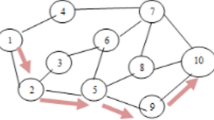Abstract
Wireless Sensor Networks (WSNs) comprises tiny sensor nodes which have been used for various applications such as Health Monitoring, Forest Fire Detection, Data Collection, Temperature Sensing, Military Application, and Security applications. Among the applications, Security in WSNs is the most challenging one because faulty information can be easily injected into the network by the intruder/attacker. Faulty information injection at the sink level may reduce the lifetime of the network and also energy wastage due to the difficulty in updating information with Base Station (BS). Two algorithms are proposed to detect and drop the false data such as Prevention of False Data Injection using Advanced Encryption Standard (PFDIAES) and Prevention of False Data Injection with Fuzzy-based method (PFDIF). The proposed improved energy-efficient faulty information extraction using PFDIF and PFDIAES algorithms is used to filter and prevent false data at the destination node. To analyze the performance of the network in critical condition, the gang attack is also considered. From the simulation results, PFDIAES has an average energy efficiency value of 1.7% and PFDIF has 5.5% of energy efficiency than the existing algorithms such as AES and FUZZY-based method.
Access this chapter
Tax calculation will be finalised at checkout
Purchases are for personal use only
Similar content being viewed by others
References
Bhattacharyya, D., Kim, T.-H., Pal, S.: A comparative study of wireless sensor networks and their routing protocols. Sensors 10 (2010)
Chong, C.-Y., Kumar, S.P.: Sensor networks: evolution, opportunities and challenges. Proc. IEEE 91(8) (2003)
Lu, R., Lin, X., Zhu, H., Liang, X.: BECAN: A bandwidth—Efficient cooperative authentication scheme for filtering injected false data in wireless sensor networks. IEEE Trans. Parallel Distrib. Syst. 23(1), 32–43 (2012)
Haider, T., Yusuf, M.: A fuzzy approach to energy optimized routing for wireless sensor networks. Int. Arab J. Inf. Technol. 6(2), 179 (2009)
Kim, M., Kim, Y., Cho, H.: Design of cryptographic hardware architecture for mobile computing. J. Inf. Process. Syst. 5(4), 187 (2009)
Zhange, Z., Jiang, C.: False data injection—Resilient security routing protocols for wireless sensor networks. J. Netw. 7(12), 2025–2030 (2012)
Godbole, V.: Performance analysis of clustering protocol using fuzzy logic for wireless sensor network. IAES Int. J. Artif. Intell. (IJ-AI) 1(3), 103–111 (2012)
Shahina, K., Pavithran, A.: Filtering scheme for injected false data in WSN. IOSR J. Comput. Eng. 13(6), 29–31 (2013)
Benamar, K., Djilalli, M., Mohammed, F., Abdellah, M.: An efficient key management scheme for hierarchical wireless sensor networks. Wirel. Sens. Netw. 2012(4), 155–16 (2012). http://dx.doi.org/10.4236/wsn.2012.46022
Jiang, H., Sun, Y., Sun, R., Xu, H.: Fuzzy-logic-based energy optimized routing for wireless sensor networks. Int. J. Distrib. Sens. Netw. 2013(216561) (2013)
Yang, X., Lin, J., Yu, W., Moulema, P.M., Fu, X., Zhao, W.: A novel en-route filtering scheme against false data injection attacks in cyber-physical networked systems. IEEE Trans. Comput. 64(1), 4–18 (2015)
Vuran, M.C., Akyildiz, I.F: Spatial correlation—Based collaborative medium access control in wireless sensor networks. IEEE ACM Trans. Netw. 14(2), 316–329 (2006)
Lee, H.Y., Cho, T.H.: Fuzzy-based adaptive threshold determining method for the interleaved authentication in sensor networks. In: Proceedings of 5th Mexican International Conference on Artificial Intelligence. Lecture Notes in Computer Science, Advances in Artificial Intelligence, vol. 4293, pp. 112–121 (2006)
Moon, S.Y., Cho, T.H.: Key index-based routing for filtering false event reports in wireless sensor networks. IEICE Trans. 95-B(9), 2807–2814 (2012)
Gao, Zhipeng, Cheng, Weijing, Qiu, Xuesong, Meng, Luoming: A missing sensor data estimation algorithm based on temporal and spatial correlation. Int. J. Distrib. Sens. Netw. 2015, 1–10 (2015)
Author information
Authors and Affiliations
Corresponding author
Editor information
Editors and Affiliations
Rights and permissions
Copyright information
© 2020 Springer Nature Singapore Pte Ltd.
About this paper
Cite this paper
Kalaivaani, P.T., Krishnamoorthy, R. (2020). An Improved Energy-Efficient Faulty Information Extraction Scheme Using PFDIAES and PFDIF Algorithms. In: Pant, M., Kumar Sharma, T., Arya, R., Sahana, B., Zolfagharinia, H. (eds) Soft Computing: Theories and Applications. Advances in Intelligent Systems and Computing, vol 1154. Springer, Singapore. https://doi.org/10.1007/978-981-15-4032-5_79
Download citation
DOI: https://doi.org/10.1007/978-981-15-4032-5_79
Published:
Publisher Name: Springer, Singapore
Print ISBN: 978-981-15-4031-8
Online ISBN: 978-981-15-4032-5
eBook Packages: Intelligent Technologies and RoboticsIntelligent Technologies and Robotics (R0)




